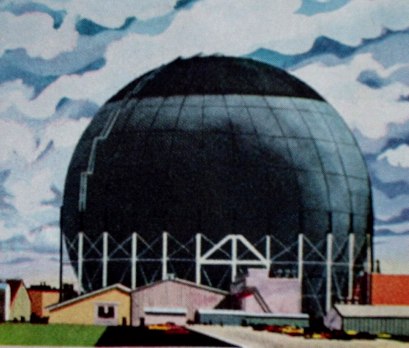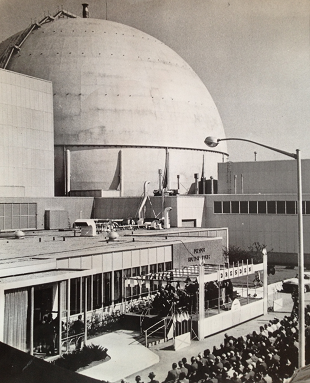Five Fast Historic Nuclear Surprises
In deference to the holiday season, I've decided to run something lighter than usual - an almost-listicle describing five historic nuclear facts that might surprise people in the field young and old!
1. The first US sale of energy generated by nuclear power was from a Navy prototype.

Navy SIR prototype from Bechtel Corporation artwork in author's collection.
Although the 1950's are filled with historic names like EBR-II and Shippinport as regards the progression toward viable generation of electricity by atomic power, the first actual paid sale of such energy in the US happened in upstate New York on July 18, 1955 - two years plus before the startup of Shippingport. This event occurred at the Navy's Submarine Intermediate Reactor prototype plant at the Kesselring Site, West Milton New York as the prototype's power was applied to the local grid accompanied by a now largely-forgotten ceremony at the site. The essentially experimental nature of the plant as well as its small output made continued sale wholly impractical, but in terms of historic milestones the event remains significant. (See more here.)
2. Fluid fueled reactors already came and went in the 1950's.
Enthusiasts of nuclear power today are often found touting fluid fuel, or molten salt reactors and their supposed advances - but did you know that a range of fluid fuel reactors was developed and sold in the 50's? These small research and training reactors, generally known at the time as "water boilers," used a solution of either uranyl sulfate or uranyl nitrate, in water. This was contained usually in a spherical shell through which cooling water and perhaps experimental rabbit tubes also passed. Oak Ridge National Laboratory designed and built two test units in the 1950's. Commercially, Atomics International sold thirteen of these for use here and abroad. Another was built by North Carolina State College and one more by Los Alamos.
There was much hope early on that this type of reactor could be expanded to commercial power plant scale, but two such projects were both developed and cancelled in the late 1950's without producing any hardware. The second one to end, the Pennsylvania Advanced Reactor project included Westinghouse and a number of utilities who all walked away from the project in unison when it was determined that too many technical problems existed and, not surprisingly as a result, that there was no chance of any economic return in the foreseeable future. These events coupled with a vessel failure at a test reactor at Oak Ridge led the AEC to decide in 1959 that the aqueous homogeneous reactor showed no chance of short term success (and in fact neither at that time did any other even less well-developed fluid fuel concepts) with the result being the defunding of this concept. Still, it remains fact that over a dozen "fluid fuel" reactors were built and sold commercially.
3. The first completely privately-funded nuclear plant was built in the 1950's.

Dresden Nuclear Power Station dedication ceremony, October 12 1960
We hear all the time from detractors of nuclear energy today that it "always requires heavy government subsidy." That may be true for lots of the basic R&D, but it's also a fact that one of the very earliest commercial nuclear power plants was built completely with private money. Dresden Nuclear Generating Station in Illinois commenced construction in June 1957 as a project funded by The Nuclear Power Group - an association consisting of American Electric Power Service Corporation, Bechtel Corporation, Central Illinois Light Company, Commonwealth Edison Company, Illinois Power Company, Kansas City Power & Light Company, Pacific Gas & Electric Company, and Union Electric Company.) The plant started up in October 1959 and achieved full power operation in June 1960. The project was built by General Electric as a "turn key" plant under a fixed price contract with Bechtel Corporation acting as A-E. So, the next time you hear that worn out knock on nuclear power just bring up Dresden!
4. There was "almost" a gas cooled reactor near Tampa, Florida.
Among the slew of conceived-but-cancelled early nuclear plants was the Florida West Coast Reactor Project, undertaken by the Florida West Coast Nuclear Group (an entity owned by Florida Power Corporation and Tampa Electric Company) and the larger East Central Nuclear Group which was made up of 14 regional utility companies. The proposed reactor was to have been a heavy water moderated, CO2 cooled type using uranium dioxide fuel. The common target for that time of 1000F steam was set, and the AEC undertook this project in its third round of Power Demonstration reactors. However, during the planning the reactor vendor, General Nuclear Engineering Corporation, decided to change from stainless steel to beryllium cladding for the fuel; the added technical complexities doomed the project, which was cancelled by the AEC formally in 1961.
5. Some early nuclear plants operated with remote load control.
When nuclear plants first came on the scene here in the United States it was considered desirable that they be controlled, at least in terms of net power output to the grid, not from the plant itself where system conditions aren't available but rather from load dispatching centers. Remote dispatching was incorporated in and used at a number of early plants such as Shippingport; some, like LaCrosse (also known as Dairyland Power Co-Op Genoa No. 2 plant) were designed to be optimized for rapid power swings while under remote load control with the operators simply "minding the store." Later, the first new generation Babcock & Wilcox PWR's with once-through steam generators were offered commercially from the start (at the end of the 60's) with remote load dispatching. Eventually the NRC decided that for safety's sake it was best that plant power only be controlled from the plant's control room itself, but one has to wonder with renewables integration looming if some new looks at this dispatching concept aren't warranted and desirable for advanced reactors. We will have to wait to see if this historic fact repeats!
 Will Davis has been a member of the Board of Directors for the N/S Savannah Association, Inc. He has been a contributing author for Fuel Cycle Week, and wrote his own popular blog Atomic Power Review. Davis is also a consultant and writer for the American Nuclear Society, and serves as Vice Chair of ANS' Book Publishing Committee. He is a former U.S. Navy reactor operator and served on SSBN-641, USS Simon Bolivar. His popular Twitter account, @atomicnews is mostly devoted to nuclear energy. He enjoys collecting typewriters, calculators and model trains and especially spending time with his nephew, Dawson.
Will Davis has been a member of the Board of Directors for the N/S Savannah Association, Inc. He has been a contributing author for Fuel Cycle Week, and wrote his own popular blog Atomic Power Review. Davis is also a consultant and writer for the American Nuclear Society, and serves as Vice Chair of ANS' Book Publishing Committee. He is a former U.S. Navy reactor operator and served on SSBN-641, USS Simon Bolivar. His popular Twitter account, @atomicnews is mostly devoted to nuclear energy. He enjoys collecting typewriters, calculators and model trains and especially spending time with his nephew, Dawson.

